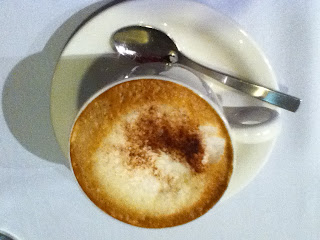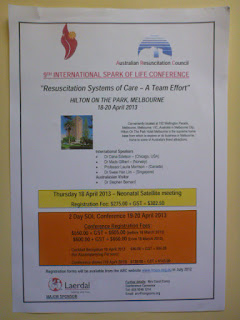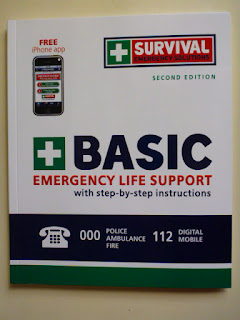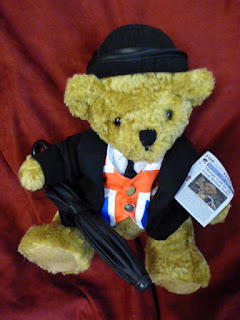Australian Resuscitation Council (Victorian Branch) 5th State Conference. Resuscitation 2012: Translating Evidence into Practice.
This was another excellent conference and networking opportunity. There was also a trade display exhibiting a number of new innovations in resuscitation equipment.
The organising committee (all volunteers) did a wonderful job.
Attendees received a 'showbag' on arrival, which included:
- program, name tag and ballpoint pen;
- Statement of Participation;
- flier for the next ARC conference (18-20 April 2013 in Melbourne);
- Mayo Healthcare information on i-gel supraglottic airway, Disposable Resuscitator and EZ-IO intraossesous access system;
- information on Cardiac Science Power Heart AED;
- Everyday Learning CPR Training Manual, BLS pocket card and information brochure (www.everydaylearning.com.au) [Note: The CPR guide is a very high quality resource]; and
- Survival Emergency Solutions CPR Emergency Handbook, Basic Emergency Life Support Guide, First Aid Emergency Handbook and instructions for downloading their iFirstAid app and the ePulication for the Emergency Handbook (www.survival.net.au).
Mayo Healthcare gave away some CPR Pocket Masks (and pens) to people who visited their table, and Survival saved the best until last. Attendees who remained until after afternoon tea were given a free first aid kit. There were three different types and sizes, but I was fortunate to be one of the first in line and received one of the large 'Survival First Aid Kits' - perfect for wilderness first aid! (Photographs of the "goodies" appear at the end of this posting.)
The Welcome by Associate Professor Tony Walker, Chair of the Victorian Branch, was followed by a very personal presentation by Matt Parkinson, Comedian, Actor, Radio Presenter and cardiac arrest survivor. He told with humour and heartfelt gratitude the story of his journey from arresting at an indoor cricket game through a period of unconsciousness and therapeutic hypothermia in ICU to insertion of an implantable defibrillator and his return home and resumption of his normal life. His mates were able to commence CPR and keep him alive until the cavalry arrived, and for those present in the auditorium it was a wonderful reminder that first aid and CPR can save lives and "make a difference".
Print-outs of the Powerpoint presentations by the other speakers were not available at the time of the conference, so I made some brief written notes for each presentation and these have been typed up and can be found below.
Professor Ian Jacobs, National Chair of the ARC and Co-Chair of the International Liaison Committee on Resuscitation (ILCOR) spoke next on "Guideline Changes: Has outcome improved?".
ILCOR was formed in 1994 and has representatives from North and South America, Europe, Asia, Australia and New Zealand and South Africa. It carries out systematic reviews of resuscitation science on five-yearly basis, with the next review due in 2015. There are two major peer-reviewed journals dealing with resuscitation matters -
Circulation and
Resuscitation.
ILCOR is now moving towards continuous evidence evaluation reviews as opposed to the old system of 'batch and queue' PICO questions. In 2013 ILCOR will meet at the Spark of Life Conference in Melbourne. For each major update it plans to produce a ~30 page summary of each set of updates and other changes will be made as needed based on the evidence, not just every five years. It currently uses its own system for evaluation and labelling of evidence but for 2015 will move to GRADE.
The Utstein Templates for Resuscitation Registries measure and report like with like (reporting outcomes). These have been revised from the original templates (2004). There will be a further review in Vienna in 2012 (to be published mid-2013). The rather humorous "Tony Smith Modification to the Levels of Evidence" was presented.
The question was asked "Has survival improved?". The change from stacked shocks and one minute of CPR seemed to change home discharge from around 25% to around 35% in one study. Other studies (2000-2005) showed a modest improvement. Overall there is a small improvement, but other factors could be contributing e.g., improved community awareness, AED access, etc. However, there is also an issue of quality in CPR - a study by Ornato et al on errors in resuscitation demonstrated that these lead to less ROSC (return of spontaneous circulation), 24 hour survival and survival to discharge. As a result we need to focus on the implementation of Guidelines - do we do what we say or think we are doing?
The next speaker prior to morning tea was Professor Judith Finn, Director of the newly established Australian Resuscitation Outcomes Consortium (Aus-ROC). Her presentation provided an overview of the structure, purpose and planned activities of Aus-ROC and discussed the need for building collaborative research networks in resuscitation.
OHCA (out-of-hospital cardiac arrest) is a leading cause of death. In the USA this affects around 310,000 people per year. The statistics are not well captured in Australia. Another paper by Ornato discusses how research prioritisation and funding is not commensurate with need. For cardiac arrest (as opposed to acute myocardial infarction, stroke and heart failure) and resuscitation there is a very low number of funded studies per 10,000 deaths. Case fatality overall is around 90%. There has been little improvement in survival outcomes over time.
In North America there is the Resuscitation Outcomes Consortium and ROC Epistry (Epidemiological Registry). In a study amongst the member States there was regional variation in survival to discharge of 3% to 16.5%. In Australia in 2008 this was between 8.4% and 12.4% (EMS-treated). What are the confounders? What are the reasons for the differences?
Aus-ROC was recently established to be a multi-centre research and clinical trial coordinating body. This is presently just re cardiac arrest. There are plans to establish an 'Epistry'. The 'Chain of Survival' diagram demonstrates that good outcomes are system-based. Post-resuscitation care is also an issue that needs attention. The RINSE (paramedic) study has been looking at rapid cooling during CPR using cooled normal saline.
There are a number of ways that we can build capacity in resuscitation science, but this beings with building relationships. Funding is worthwhile from an economic perspective as practitioners are doing their best to return people to taxpayer status! At present there is $2.5million funding from the NHMRC, which is funding some post-doctoral researchers, PhD students and a part-time Director and administrative support.
After morning tea Associate Professor Julie Considine, Chair of the Basic Life Support Committee of the ARC spoke on "Basic Life Support: Understanding BLS practice from an evidence-based perspective".
The best way to get good outcomes from cardiac arrest is to prevent them from happening in the first place e.g., recognition and care of the deteriorating patient.
Danger - move someone if you have to .
Positioning:
- if unconscious/breathing, turn to lateral position; and
- face down and unresponsive - roll to supine position.
Response - signs of life removed: now unresponsive and not breathing normally.
Send for help - principle more important than actual timing.
Airway:
- takes precedence over neck;
- no need to routinely roll onto side;
- adults/children - head tilt/chin lift;
- infants - neutral; and
- finger sweep - not routinely (but yes if solid material visible).
Choking - Heimlich not recommended (evidence of harm) but still used internationally.
Breathing:
- look/listen/feel;
- now compressions then ventilations (may be different in drowning scenario/Surf Lifesaving; and
- rescue breathing - various options;
- make sure it is working; and
- may need two people for BVM.
Compressions-only CPR permissible.
During the first five minutes of cardiac arrest adults maintain an O2 saturation over 80-85%.
Ventilation not so important as opposed to uninterrupted cardiac compressions.
Cardiac arrest is not a normal physiological state, therefore reduced need for ventilation.
Over-ventilation common during CPR:
- hyperventilation/excessive tidal volumes especially if using BVM; and
- potentially harmful effects.
Barrier devices are probably helpful
Compressions - lower half of sternum; and
- pulse check unreliable.
Technique/Depth/Rate/Quality Control/Risks.
Chest compressions:
- 25-30% normal cardiac output;
- Systolic BP 60 to 80mmHg;
- Cerebral blood flow 30-40% of normal; and
- Coronary blood flow 10-20% of normal.
Coronary perfusion pressure has a direct correlation with ROSC e.g., CPP over 15mmHg.
With 30:2 keeping CPP up higher for longer.
Even experts have room for improvement technique-wise.
AEDs have a role both in and out of hospitals - accurately identify rhythms as shockable/non-shockable.
Pad placement and size:
- standard adult pads can be used in adults and children from 8 years of age; and
- can use in a child under 8 if there is no other option available.
Skin contact very important for successful defibrillation.
Safety - no reports of harm (with soft gel pads) in wet environments or presence of oxygen.
VF (ventricular fibrillation) rarely reverts spontaneously - need defibrillation.
Generally successful if occurs under 10 minutes post-arrest, but CPR can extend window.
Next we experienced a 'high octane' presentation by Associate Professor Peter Morley, Deputy National Chair and Chair of the Advanced Life Support Committee of the ARC on "Advanced Life Support: Understanding ALS practice from an evidence-based perspective".
Due to the high volume of slides and the fast pace, it was not possible to record more than a very rudimentary summary of this talk.
Answerable questions and worksheet links can be found on the ILCOR website.
Evidence supports better outcomes with ALS CPR.
Quality-wise could do better.
Too fast/too slow.
Ventilations too fast.
Compressions too shallow - depth over 5cm (5-6cm) (or 1/3 of the depth of the chest) (children 5cm, infants 4cm).
No benefit in going too fast - fatigue/leaning/cycles too short.
Metronomes can be useful.
"Goldilocks Principle".
Longer pre-shock pause - shock success less likely.
Charging defibrillator during compressions can save time.
Drugs in CPR - short-term benefits but not statistically significant in survival.
ETCO2 parallels pulmonary vascular flow.
Animal model - even 12 breaths per minute too much.
Advanced airway: 15:1 (better to synchronise).
5-6 breaths/minute probably ideal; presently in Guidelines 8-10 breaths/minute.
Mechanical CPR - promising but insufficient data at present.
(Hawthorne Effect - people perform better when aware being observed.)
Benefits from regular teaching and monthly practice (study re nurses).
Then it was time for lunch! The first presentation after lunch was by Dr Ken Winkel, Director of the Australian Venom Research Institute on "Research Translation: Snakebite in Papua New Guinea: Wokabaut wantaim - raka hebou - Walking Together".
Community first aid and application is very important in management of venomous bites and stings. This is a case of translation of research into practice. Australian and PNG snakebite issues are similar.
Injury, disability and mortality are all factors. Limb loss about 250,000 - 400,000p.a. worldwide (necrotising venom). Mortality around 80,000 - 125,000p.a. Snakebite = a neglected tropical disease. Annual cases about 4.5 - 5.4 million worldwide. Asia/Africa/South America - children can be especially vulnerable.
PNG and Australia - a single antivenom can be used for all snakebites (AVG Polyvalent). Snakebite fatality about 100x in PNG. Transportation challenges, long transfers, lack of resources. Savannah grassland - perfect taipan habitat. PNG: mean time ~4 hours to presentation (range 15mins to 48 hours).
Need to disseminiate teaching, bandages re pressure immobilisation techniques. Using another supplier to produce a similar but much cheaper antivenom. More than 1/2 ICU beds are used for snakebite (antivenom may not be available; too costly). Mortality: 15% adults, 26% paediatric. Rural: 33/100,000/year. People were rationing antivenom, only using a bit of it, waiting until someone was really sick. Need to use it early at the first sign of neurotoxicity. No dialysis in PNG.
Have set up a global snakebite initiative. Antivenom is the most cost-effective medicine in the world.
The next speaker was Associate Prfoessor Stephen Bernard, Intensive Care Specialist, Alfred Hospital, and Medical Advisor, Ambulance Victoria. He spoke on the topic of "What will post-arrest management look like in 2020?".
For instance, the person affected will be taken to the post-arrest centre for evaluation by the cardiac arrest team. Management is likely to include an SBP>100, no supplemental inspired oxygen, therapeutic hypothermia and sedation. Patients will be transported to a major cardiac centre in the same way that they are now transported to a major trauma centre. Some studies have shown better outcomes if patients are transported to a hospital that is also a major trauma centre - teamwork approach.
Increasing animal data shows that 100% oxygen may be harmful post-arrest. Bad for the brain and the heart. Exaggerated reperfusion injury. A review in Resuscitation April 2012 - pooled results favour normoxia after ROSC. An ICU study showed an association between PaO2 on first ABG after arrest and in-hospital mortality. Normoxia was more favourable. How do you provide different fractions of O2 in an ambulance (don't have blenders)? How reliable is the pulse oximeter?
Proposed Australian/NZ study for hyperoxia versus normoxia. AVOID trial - STEMI patients allocated to supplemental O2 or no supplemental O2 (?higher levels of O2 increase cardiac injury).
Push SBP 100mmHg. Improve oxygen delivery, minimise adverse cardiac effects (some research to support this).
Transport to cath lab - STEMI, shock, arrhythmias. 12 lead not sensitive enough. 58% of patients without a STEMI had a lesion.
Therapeutic hypothermia. IV/surface/core cooling (>= 24 hours post-arrest) e.g., 33 degrees Centigrade. RICH trials. Velomedix peritoneal lavage - temperature drops in 6.5 minutes to 34 degrees (maintains temperature very accurately; 34 hour automated treatment).
Post-cardiac arrest team starting at the Alfred next week (ED/Cardiology/ICU).
Cautious prognostication days 4-6. Things may not be as they seem!
The final speaker after afternoon tea was Associated Professor Jim Tibballs, Deputy Director of Intensive Care, Royal Children's Hospital, and Chair, Paediatric Advanced Life Support Committee, Australian Resuscitation Council.
The Paediatric Guidelines don't apply at birth or within a few hours after birth (Neonatal period). Once the lungs are fully expanded and pulmonary hypertension is resolved then this becomes the paediatric period.
Prefer ventilations in the paediatric world with CPR. Don't spend more than 10 seconds palpating a pulse. No IV access - go for intraosseous access. Start with 100% O2 and then titrate to PaO2 80-100mmHg. Compressions 1/3 A-P diameter. Compressions:ventilations 15:2 (may give 2 breaths first). Intubated - 10 breaths per minute. Detect expired CO2 - confirm intubation, monitor effectiveness of CPR. BVM OK, ETT better. Defibrillation single shock 4J per kg then 2 minutes CPR. Minimise interruption to compressions Asystole, bradycardia - give adrenaline. 30:2, 5 cycles in two minutes = approximately 75 compressions per minute, 5 breaths per minute.
Diagnose cardiac arrest by pulse palpation (Resuscitation 2009 and 2010). 150 doctors and nurses and paediatric patients on ECMO - does the patient have a pulse - YES/NO? Reliability 78% (wrong 22%). Sensitivity - diagnosed cardiac arrest 86% (wrong 14% - no CPR but needs it). Specificity -64% (diagnose arrest incorrectly 36% - CPR even though not needed). When pulse truly absent needed 30 seconds to decide (experienced operators 25 second, inexperienced 37 seconds). If the pulse was present the average was 13 seconds (9 seconds/21 seconds) - where the 10 seconds (for experienced operator) comes from. Don't ask laypersons to feel for a pulse.
Animal models (and mathematical) - 30:2 favoured for O2 transport. If low ratios, too much time off chest, too much ventilation. 15:2 - paediatric ventilation requirement greater than for an adult. Hypoxic arrest/asphyxia more common. Asphyxial cause - standard CPR. Cardiac cause - standard CPR or compressions only fairly effective. 15:2, 5 cycles in 1 minute - approximately 75 compressions and 10 breaths in a minute.
Why resume ECC immediately after DC shock? The importance of not interrupting ECC (more interruptions result in worse outcome, reduced survival and lower probability of successful defibrillation). Importance of restricting ventilations. Efficacy of a single shock.
Why the adverse effects of 'hands-off'? Coronary perfusion pressure during CPR: with increasing number of compressions the aortic pressure rises above right atrial pressure. Excessive ventilations reduces survival. Less ventilation results in increased CPP and increased pulmonary blood flow. Adequate chest rise in an adult = 5=6mL/kg.
If stacked shocks, 84%/8%/5% likelihood of success. ROSC not synonymous with successful defibrillation. ECC - push hard, push fast, don't interrupt! Ventilate to ETCO2. Children - better ROSC with 3-5J/kg (where the 4J comes from) but better to use adult AED if have nothing else available. ETCO2 monitoring - ETT detection, assess effectiveness of CPR (ETCO2 >15mmHg).
Watch this space!
The 9th International Spark of Life Conference "Resuscitation Systems of Care - A Team Effort" will be held at the Hilton on the Park, Melbourne on 18-20 April 2012. For further details see:
www.resus.org.au.


















































